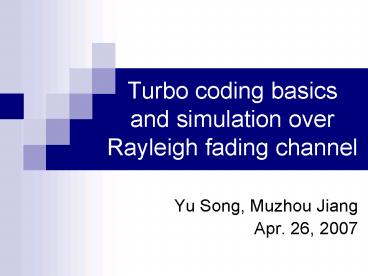Turbo coding basics and simulation over Rayleigh fading channel - PowerPoint PPT Presentation
1 / 14
Title:
Turbo coding basics and simulation over Rayleigh fading channel
Description:
Good approx. for time-variant channel in densely-built places (Manhattan) ... Linear-log-MAP algorithm is used in decoder. Convolutional Code: K = 4, Rate ... – PowerPoint PPT presentation
Number of Views:1173
Avg rating:3.0/5.0
Title: Turbo coding basics and simulation over Rayleigh fading channel
1
Turbo coding basics and simulation over Rayleigh
fading channel
- Yu Song, Muzhou Jiang
- Apr. 26, 2007
2
Outline
- Introduction to Turbo Codes
- Turbo Encoder
- Turbo Decoder
- Rayleigh Fading Channel intro
- Simulations
3
Introduction
- High-performance error correction codes
- Devised by Berrou et al. 1 in 1993
- Advantages
- Low BER at SNR close to Shannon limit
- Or for a certain BER, power can be decreased
- Drawbacks
- High decoder complexity
- Relatively high latency due to interleaving and
- iterations when decoding
4
Turbo Encoder
- Two recursive systematic convolutional encoder in
parallel with an interleaver preceding one of
them
Payload bits
Input
RSC1
Optional Puncturing
Parity bits 1
Interleaver
Parity bits 2
RSC2
5
Turbo Encoder for UMTS
Xk
Zk
D
D
D
Xk
Interleaver
Zk
D
D
D
Xk
6
Turbo Decoder
- Log-Likelihood Ratio (LLR) is used as input to
decoder - Matched filter must be scaled (ak is channel
response, is variance of nk )
(Received signal)
7
Turbo Decoder Architecture
- Soft-In-Soft-Out, Modified Viterbi Algorithm
- Iterative Decoding
Extrinsic Information 1
RSC DEC. 1
LLR(Xk)
Extrinsic Information 2
LLR(Zk)
RSC DEC. 2
Interleaver
De- Inter
LLR(Zk)
8
Rayleigh fading
- Good approx. for time-variant channel in
densely-built places (Manhattan) - Signals transmitted through multiple reflective
paths, no line-of-sight path
9
Rayleigh fading modeling
- Channel model
- is a Rayleigh random variable,
- are both Gaussian R.V.
10
Simulation set-up
- BPSK Modulation
- Turbo Code
- Generators g1 g2 1 0 1 1, 1 1 0 1
- Frame size of 640 bits
- Linear-log-MAP algorithm is used in decoder
- Convolutional Code
- K 4, Rate ½
- g1 1 0 1 1, g2 1 1 0 1
11
Simulation results -- AWGN
12
Simulation results -- Rayleigh
13
Simulation results -- Iterations
14
References
- 1 C. Berrou, A. Glavieux and P. Thitimajshima,
Near Shannon Limit Error-Correcting Coding and
Decoding Turbo Codes, Proc. 1993 IEEE
International Conference on Communications, pp
1064-1070, 1993 - 2 http //www.wikipedia.com
- 3 M. C. Valenti and J. Sun, The UMTS Turbo Code
and an Efficient Decoder Implementation Suitable
for Software-Defined Radios, International
Journal of Wireless Information Networks, Vol. 8,
No. 4, pp. 203-215, 2001 - 4 M. C. Valenti and J. Sun, Turbo codes,
Chapter 12 in Handbook of RF and Wireless
Technologies, Edited by F. Dowla Editor, Newnes
Press, 2004, pp. 375-399 - 5 B. Sklar, Rayleigh Fading Channels in Mobile
Digital Communication Systems Part I
Characterization, IEEE Communications Magazine,
pp. 90-100, July 1997 - 6 http//www.iterativesolutions.com/Matlab.htm
- 7 L. F. Choy, I. J. Fair, W. A. Krzymien,
Complexity-Performance Trade-offs in Turbo Codes
for IMAT-2000, 2000 IEEE Vehicular Technology
Conference, pp. 2568-2575































